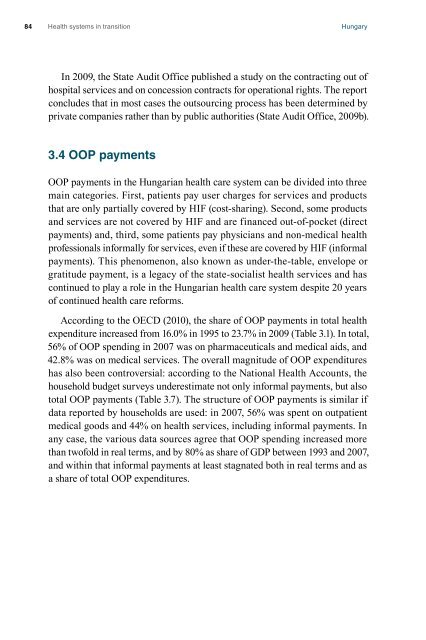Health Systems in Transition - Hungary - World Health Organization ...
Health Systems in Transition - Hungary - World Health Organization ...
Health Systems in Transition - Hungary - World Health Organization ...
Create successful ePaper yourself
Turn your PDF publications into a flip-book with our unique Google optimized e-Paper software.
84<br />
<strong>Health</strong> systems <strong>in</strong> transition <strong>Hungary</strong><br />
In 2009, the State Audit Office published a study on the contract<strong>in</strong>g out of<br />
hospital services and on concession contracts for operational rights. The report<br />
concludes that <strong>in</strong> most cases the outsourc<strong>in</strong>g process has been determ<strong>in</strong>ed by<br />
private companies rather than by public authorities (State Audit Office, 2009b).<br />
3.4 OOP payments<br />
OOP payments <strong>in</strong> the Hungarian health care system can be divided <strong>in</strong>to three<br />
ma<strong>in</strong> categories. First, patients pay user charges for services and products<br />
that are only partially covered by HIF (cost-shar<strong>in</strong>g). Second, some products<br />
and services are not covered by HIF and are f<strong>in</strong>anced out-of-pocket (direct<br />
payments) and, third, some patients pay physicians and non-medical health<br />
professionals <strong>in</strong>formally for services, even if these are covered by HIF (<strong>in</strong>formal<br />
payments). This phenomenon, also known as under-the-table, envelope or<br />
gratitude payment, is a legacy of the state-socialist health services and has<br />
cont<strong>in</strong>ued to play a role <strong>in</strong> the Hungarian health care system despite 20 years<br />
of cont<strong>in</strong>ued health care reforms.<br />
Accord<strong>in</strong>g to the OECD (2010), the share of OOP payments <strong>in</strong> total health<br />
expenditure <strong>in</strong>creased from 16.0% <strong>in</strong> 1995 to 23.7% <strong>in</strong> 2009 (Table 3.1). In total,<br />
56% of OOP spend<strong>in</strong>g <strong>in</strong> 2007 was on pharmaceuticals and medical aids, and<br />
42.8% was on medical services. The overall magnitude of OOP expenditures<br />
has also been controversial: accord<strong>in</strong>g to the National <strong>Health</strong> Accounts, the<br />
household budget surveys underestimate not only <strong>in</strong>formal payments, but also<br />
total OOP payments (Table 3.7). The structure of OOP payments is similar if<br />
data reported by households are used: <strong>in</strong> 2007, 56% was spent on outpatient<br />
medical goods and 44% on health services, <strong>in</strong>clud<strong>in</strong>g <strong>in</strong>formal payments. In<br />
any case, the various data sources agree that OOP spend<strong>in</strong>g <strong>in</strong>creased more<br />
than twofold <strong>in</strong> real terms, and by 80% as share of GDP between 1993 and 2007,<br />
and with<strong>in</strong> that <strong>in</strong>formal payments at least stagnated both <strong>in</strong> real terms and as<br />
a share of total OOP expenditures.
















